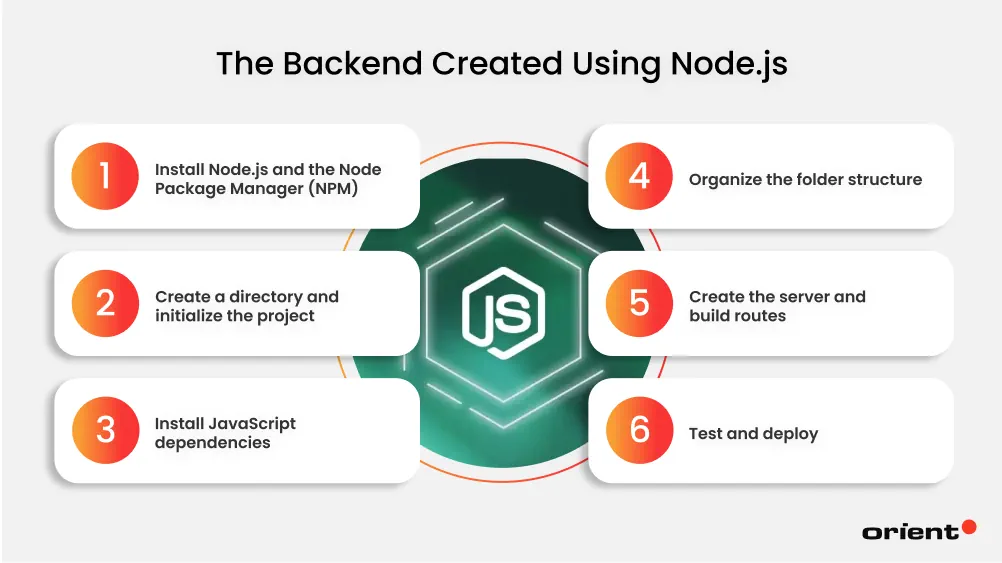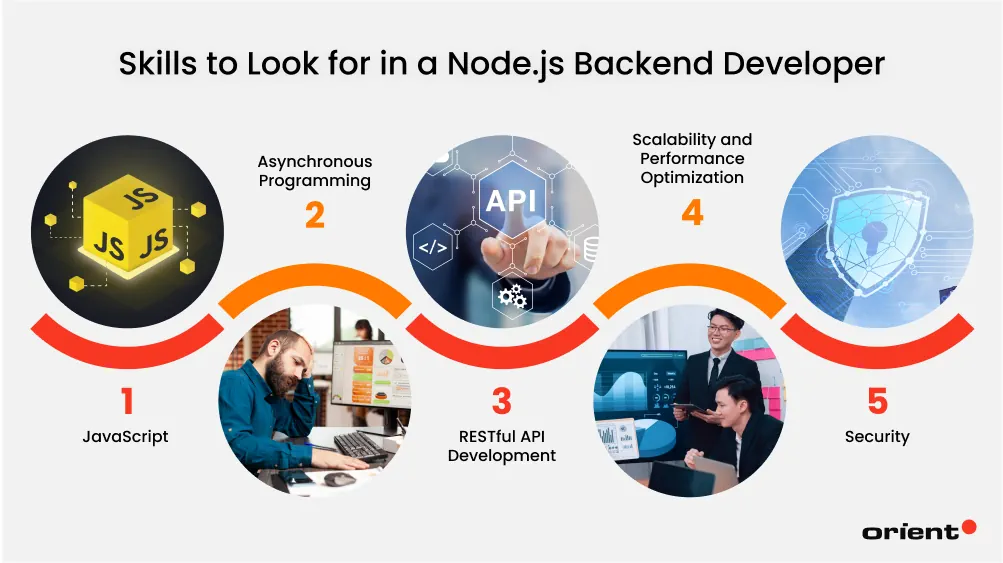Choosing the right backend technology is vital to the success of your web application. It defines the internal, non-interactable logic of your app, ranging from security to performance to data retrieval and collection. It also defines the app’s ability to interact with other software applications via its application programming interface (API).
Node.js is a popular backend technology that has gained prominence over the years. It allows JavaScript code to run outside the client’s browser, enabling the use of the same programming language across both the front and backend.
In this article, you’ll learn all you need to know about Node.js for backend development. You’ll learn what Node.js is, its advantages and disadvantages, and how to incorporate Node.js into the backend of your app.
Key Takeaways:
- Node.js is a well-known backend solution for web app development due to its speed and efficiency, compatibility with JavaScript, and ease of use.
- Due to its event-driven architecture and non-blocking functionality, Node.js can facilitate a large volume of requests simultaneously, resulting in a more responsive user experience.
- When partnering with a development team, they give you advice on the benefits and potential drawbacks of Node.js for the backend. They can then help you make an informed choice that ultimately benefits your end product.
What Is Node.js?
Node.js is a cross-platform, open-source runtime environment (RTE) that executes JavaScript code outside the browser. Developed by Ryan Dahl in 2009, Node.js was created in response to JavaScript’s limitations at the time. For example, it being limited to a frontend technology for web browser apps.
![What Is Node.js??]()
Node.js overcomes the limitations of what you can do with JavaScript by allowing code written in JavaScript to be executed outside the browser. As a cross-platform RTE, Node.js programs can be executed on Windows, Linux, and macOS. And, as an open-source technology, Node.js is free to use and is updated regularly by a global community of dedicated Node.js developers.
Is Node.js Useful for Backend Development?
Node.js is a powerful backend development tool. It offers various functionalities that are perfect for backend development, such as single-threaded processing, event loops, and non-blocking I/O operations.
Programs that use multi-threaded processing must create a new thread to process each new request, and there is a limited pool of threads to choose from. Once the available pool of threads runs out, the program must wait until a new thread is available to complete a new request. The result is a performance slowdown and longer waiting times for users.
By comparison, multi-threaded processing allows Node.js programs to process several concurrent requests at once, without the risk of over-allocating resources like memory. This makes Node.js programs great for real-time applications, such as live chat.
As a result, Node.js has become renowned for its speed and efficiency, and has been praised by developers for its ability to deliver smooth response times and handle a large volume of concurrent requests.
What Are the Benefits of Node.js for Backend Development?
The main Node.js advantages for backend development are that it is:
- Extremely versatile: Since Node.js allows developers to use JavaScript for both the front and backend, developers can reuse multiple components across both ends with the same shared language. This helps speed up development, as it eliminates the need to hire and onboard developers with proficiency in programming languages other than JavaScript.
- Supported by a knowledgeable community: Node.js has been around since 2009, and has culminated in a devoted community since then. Chances are, if a developer encounters a problem while working on your project, someone else has shared a solution on Stack Overflow. This helps developers save time on troubleshooting, meaning they can get your product to launch faster and at a lower cost to you, the valuable client.
- Code reusability: By using frameworks like Express.js and Meteor.js, developers can use JavaScript on both the front and backend, facilitating shared language and components across the entire system. This helps reduce context switching between the front and backend, enhancing developer efficiency. Code reusability also makes it easier to maintain Node.js programs, as updates and fixes can be applied across the board in one place.
What Are the Potential Drawbacks of Using Node.js for Backend Development?
Like all things in life, there are drawbacks to the choices we make. The same applies to your choice of backend technology. What works for one project may not work for another. By partnering with a trusted technology partner, they can help you choose the right backend technology for your project.
![What Are the Potential Drawbacks of Using Node.js for Backend Development?]()
At Orient Software, we thoroughly evaluate your existing tech stack and business goals. This enables us to determine if a backend technology like Node.js is compatible with your tech stack, and if it’ll help achieve your short- and long-term goals.
Below are some potential drawbacks to using Node.js for backend development
- Can struggle with heavy computing tasks: Node.js is great at data processing, and can handle several concurrent tasks at once. However, it requires a lot of CPU power to handle an increasing volume of risks. If the number of requests exceeds the system’s computing capabilities, then the program will exhibit performance issues such as slow-loading pages and potential crashes.
- May not be suitable for legacy projects: For legacy projects where the app is already using separate languages for the front and backend, making the switch to Node.js for the backend could be a challenge. Since legacy systems are built on outdated technology and infrastructure, they may be incompatible with the advanced features afforded to users who adopt Node.js programs. That said, this challenge didn’t major players like Netflix and Uber from switching their legacy backend systems to Node.js, so there’s hope still for smaller companies willing to embrace the change.
- Unpredictable quality of libraries and modules: Since Node.js is an open-source RTE, anyone can create and upload their libraries and registries for users to use. The problem with this is that not every library or registry will be of the same quality. Not only can downloading the wrong third-party components introduce performance and incompatibility issues, but also security risks due to unpatched vulnerabilities.
How Is the Backend Created Using Node.js?
When incorporating Node.js into the backend of a web app, there are many steps to follow. By understanding what these steps entail, you can better understand how different software development teams approach the matter to deliver the best possible user experience.
![How Is the Backend Created Using Node.js?]()
We, Orient Software, pride ourselves on providing clear, upfront, and consistent communication. We keep you informed on each step of the process, from consultation to development to release. This assures you that each decision we make, from your choice of backend technology, is made to help achieve the best possible outcome for you.
This is a simplified breakdown of the steps involved in using Node.js for the backend:
1. Install Node.js and the Node Package Manager (NPM) – These are available to download from the official Node.js website.
2. Create a directory and initialize the project – Developers create a new directory to store all of their project files. A well-organized directory makes it easier for developers to navigate their project files, streamlining developer productivity and efficiency. Developers then create a package .json file, which contains the metadata and dependencies.
3. Install JavaScript dependencies – From there, developers install the necessary libraries and modules based on the client’s technical requirements. This is achieved with the NPM, which allows for easy integration of Node.js components into a project.
4. Organize the folder structure – Next, developers need to organize the folders in their Node.js project, ensuring files are properly categorized and easily accessible. Common Node.js project sub-directories include controllers, models, middleware, routes, and node modules. Again, teams who properly organize their folders have an easier time collaborating and maintaining code.
5. Create the server and build routes – Following this, developers create the server by importing the necessary modules and creating an HTTP server to facilitate the request/response callback function. They then define the routes within the server.js file, which specifies what ports the server should listen to so it can handle incoming HTTP requests.
6. Test and deploy – Finally, once the routes are set up, the developers test them by opening the server in a web browser. The backend is then deployed to a hosting service or cloud platform, and regularly maintained to ensure it runs safely and securely.
Skills to Look for in a Node.js Backend Developer
Now that you know how the backend is developed in a Node.js project, the next step is to choose the right backend development team.
![Skills to Look for in a Node.js Backend Developer]()
In many cases, it’s not enough for a developer to be proficient in just JavaScript and Node.js. They must also possess skills in other aspects of backend development, such as knowledge in asynchronous programming, database management, and RESTful API development.
Important skills to look for in a Node.js backend developer are:
JavaScript
Since Node.js is designed specifically to execute code written in JavaScript, it is only natural that Node.js developers be proficient in JavaScript. They should have expert knowledge in server-side development and networking applications, event-driven models, and asynchronous programming. These skills enable Node.js developers to create fast, clean, and efficient backend systems that meet a variety of business needs.
Orient Software has a dedicated team of Node.js developers with years of experience creating JavaScript applications. We know how to maximize the benefits of these technologies, such as their ability to use the same shared language across the front and backend. This helps streamline rapid development by encouraging code reusability, making it easier to implement updates across the board.
Asynchronous Programming
Asynchronous programming allows an app to process concurrent tasks at once, without waiting for any task to be completed before moving onto the next one.
Node.js developers should be proficient in all aspects of asynchronous programming, such as being familiar with callback parameters and promises. Promises help asynchronous operations function more smoothly, while callbacks determine the outcome of specific actions.
Therefore, learning these concepts is essential to maximizing the productivity benefits of asynchronous programming.
RESTful API Development
Most modern web apps rely on RESTful API development to allow two or more systems to communicate with each other.
Node.js developers should know how to work with APIs, which includes knowing how to perform caching, authentication, and the handling of HTTPS requests. This knowledge ensures developers can deploy Node.js apps that interact seamlessly with other APIs.
Scalability and Performance Optimization
Node.js programs are typically designed to grow and scale in line with a business’s dynamic, changing needs.
Therefore, Node.js developers should have a deep understanding of microservices architecture. This makes it possible for them to develop Node.js apps that are split up into individual services, categorized snippets of code, and other components that can be maintained independently, separately from the rest of the source code.
Proficiency in this area will allow your Node.js app to handle increasingly large traffic volumes and more complex functionalities.
Security
Node.js developers should have a deep understanding of the latest cybersecurity best practices. This means being informed on how to secure data in transit and at rest, implement strong authentication policies, and limit request sizes, among more.
For example, the default request size limit in Node.js is 5mb. However, this limit can be lowered. This helps prevent JavaScript code from being compromised by a DDoS attack. This way, threat actors cannot flood your web servers with an over-abundance of requests.
By following these cybersecurity best practices, clients (like yourself) are assured that your Node.js application is safe from both internal and external security threats.
Let Orient Software Handle Your Node.js Backend Development
Node.js is a powerful front-end and back-end tool that can bring a variety of innovative business ideas to life. If you’re interested in incorporating this technology into your next project, talk to the experts at Orient Software today.
![Let Orient Software Handle Your Node.js Backend Development]()
Our Node.js development team would love to hear from you. We’ll listen to your ideas, evaluate your existing tech stack, and review your business goals. From there, we can propose a custom web app solution that is right for your business.
Contact us today. Discover how our Node.js development backend services can help your business grow.













